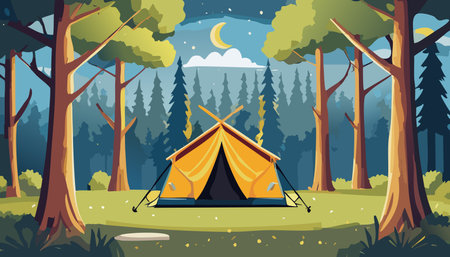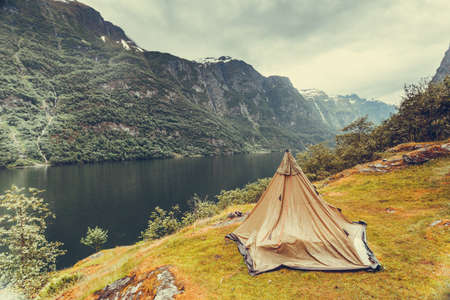Understanding UK Wild Camping Etiquette
Wild camping across the United Kingdom is a cherished tradition, woven into the fabric of British outdoor culture. Yet, beneath the thrill of setting up camp under ancient oaks or beside misty moors lies a tapestry of unwritten rules—a silent pact between camper and countryside. Respecting these customs is not only about following guidelines, but about preserving the soul-stirring beauty that makes the British landscape so inviting.
Unlike some countries where wild camping is permitted almost everywhere, in the UK it often relies on quiet consent and mutual understanding. In Scotland, the Land Reform Act grants more freedom, but in England, Wales, and Northern Ireland, campers must seek permission from landowners unless on designated access land. This etiquette extends beyond legality; it’s about leaving no trace of your passage—treading lightly so that fields remain unspoiled, bluebells undisturbed, and wildlife unstartled.
Adhering to these traditions means more than just avoiding litter. It encompasses choosing discreet pitches away from homes and farms, keeping noise to a gentle hum, and practising responsible fire management. By embracing this ethos, wild campers honour both the land and those who cherish it—locals whose roots run deep, and fellow adventurers who follow in your footsteps. It’s an invitation to become part of a longstanding legacy: one where reverence for nature is as important as adventure itself.
2. Fire Laws and Regulations in the British Countryside
The rugged beauty of the British countryside, from the misty dales of Yorkshire to the wild, rolling Highlands, has long called adventurers to its heart. Yet with such privilege comes responsibility—especially when it comes to managing fire. Across England, Scotland, and Wales, open fires are governed by a tapestry of legal considerations and by-laws designed to preserve these cherished landscapes for generations to come. Understanding these rules is essential for any wild camper who wishes to leave no trace and tread lightly upon the land.
Legal Considerations: A Patchwork of Rules
Fire regulations vary not only from country to country within the UK but often from one local authority or landowner to another. Wild campers must be aware that what’s permitted in one region may be strictly prohibited in another. In many areas, open fires are either restricted or banned outright, especially during dry spells or in protected habitats.
Key Differences Across England, Scotland, and Wales
| Country | General Law | Notable By-Laws | Special Considerations |
|---|---|---|---|
| England | Open fires generally discouraged; often illegal on open access land under the Countryside and Rights of Way Act 2000. | National parks and nature reserves commonly enforce stricter bans; permissions may sometimes be granted by private landowners. | High fire risk periods may see temporary bans; always check local signage and authorities. |
| Scotland | The Land Reform (Scotland) Act 2003 allows responsible access, including small campfires if done safely and without damage. | Some areas, like Loch Lomond & The Trossachs National Park, have seasonal restrictions or require permits for fires. | “Leave No Trace” principles strongly emphasised; avoid fires during high-risk times. |
| Wales | No general right to light fires; permission required from landowners. | Bans are common in upland and coastal regions; national parks often prohibit all open flames. | Strict penalties for breaching fire by-laws; always seek explicit consent. |
Navigating Permissions and Respecting Local Customs
Before striking a match, wild campers should always research their chosen area—consulting park authorities, local councils, or landowners as appropriate. Even where the law appears permissive, it is vital to respect posted signs and community expectations. Many areas now provide dedicated fire pits or allow only raised stoves as a compromise between tradition and conservation. By honouring both legal requirements and the unspoken etiquette of the countryside, we ensure that our fires warm only our hearts—not scar the landscape we hold dear.

3. Selecting Safe and Sustainable Fire Sites
In the gentle embrace of the British countryside, every decision we make as wild campers leaves its trace on ancient landscapes and living habitats. When it comes to building a campfire, discretion and sensitivity are your most valuable guides. Choosing the right location is not just about convenience; it’s a matter of respect for both nature and heritage.
Steering Clear of Sensitive Habitats
The UK’s wild places are stitched together by rare heaths, mossy woodlands, and protected peat bogs. These delicate ecosystems can be irreversibly damaged by a single fire. Always avoid pitching up near areas where the flora looks particularly lush, or where wildlife signs are evident—these are often sites of ecological significance. Instead, seek out already established clearings or durable surfaces like gravel, bare soil, or sand, where your fire won’t scar the earth.
Avoiding Dry Grass and Fire Risks
While the golden hues of summer meadows may look inviting, dry grass is highly flammable and poses a serious risk of wildfire—especially during warm spells in late spring and summer. Even a small spark can ignite an uncontrollable blaze, threatening not only your safety but also that of local communities and wildlife. Opt for spots well away from tall grass, bracken, or any undergrowth that could catch alight with ease.
Respecting Historic Sites and Scenic Beauty
The UK is woven with history—ancient stone circles, ruined abbeys, and centuries-old dry-stone walls dot the landscape. These sites are irreplaceable and deserve our utmost care. Never build fires on or near archaeological remains or historic landmarks; instead, appreciate their quiet presence in the landscape from a respectful distance. Choose locations where your fire will blend into the surroundings, leaving no visual blight upon these cherished views when you depart.
By carefully selecting your fire site, you play a part in safeguarding the beauty and balance of Britain’s wild places for those who wander after you. Let your presence be gentle—a whisper among old trees and rolling hills—so that the only mark you leave behind is one of reverence.
4. Methods for Building Low-Impact Fires
In the wild embrace of the British countryside, where ancient woodlands meet rolling moorland and soft rain falls like a whispered promise, the art of fire takes on both practical necessity and gentle reverence. For those who camp in the wild places of the UK, practising responsible fire management is not just about warmth or cooking—its about treading softly upon the land, leaving it as untouched as you found it.
Portable Stoves vs. Open Fires: A Thoughtful Choice
The modern wild camper is often faced with a choice: should you bring a portable stove, or is an open fire justified? Each method has its own place in the British landscape, but their impact differs greatly. The table below compares these two options, considering both practical and aesthetic dimensions:
| Aspect | Portable Stove | Open Fire |
|---|---|---|
| Environmental Impact | Minimal; leaves no marks on ground | High if unmanaged; risk of scarring earth |
| Aesthetic Value | Functional, less atmospheric | Visually pleasing; traditional campfire experience |
| Ease of Use | Quick setup and pack away; reliable in wet weather | Requires time to gather wood, build safely, extinguish fully |
| Leave No Trace Compliance | Excellent; easy to follow principles | Difficult unless proper methods are used (see below) |
| Legal Considerations (UK) | Generally permitted where camping is allowed | Often restricted; check local bylaws and landowner permissions |
The Art of the Minimal Fire: Creating a Discreet Fire Pit
If you decide that an open fire is appropriate and permitted, honouring the principle of ‘leave no trace’ is paramount. Choose your spot carefully—look for existing clearings or stony riverbeds rather than fragile grass or peat. Gather only deadwood already on the ground; never break branches from living trees.
Steps for Building a Low-Impact Fire Pit:
- Select a Site: Use established fire sites if available. Avoid areas under low-hanging branches or close to bracken and heather.
- Create a Barrier: If there’s no fire ring, arrange stones in a tight circle to contain flames and heat. Alternatively, dig a shallow pit (no more than 15cm deep) to shield your fire from wind.
- Prepare Fuel: Use only small twigs and sticks, keeping your fire compact—no larger than necessary for your needs.
- Tend with Care: Never leave your fire unattended. Keep water nearby for emergencies.
- Total Erasure: Once finished, douse thoroughly with water until all embers are cold. Scatter ashes thinly far from camp and restore the site by replacing any turf or stones disturbed.
The Aesthetic Touch: A Campfire That Leaves No Memory
A well-managed fire need not mar the landscape. Let your flames be brief companions—flickering storytellers whose only legacy is warmth shared beneath starlit skies. As dawn blushes across the moors or woodland glades, ensure that all signs of your presence vanish into the morning mist. In this way, we become part of nature’s quiet poetry—honouring both beauty and responsibility as we wander the wild heart of Britain.
5. Extinguishing and Concealing Your Campfire
As the hush of dusk settles over the wild British landscape, the true art of responsible fire management emerges—not in the lighting, but in the leaving. The Leave No Trace ethos insists that wild campers tread lightly, ensuring nature remains untarnished for the next wanderer. Here’s a gentle, step-by-step guide to extinguishing and concealing your campfire, blending practical care with reverence for the land.
Step 1: Allow Time for a Complete Burn
Before even thinking about packing up, let your fire burn down to fine ash. Avoid dousing roaring flames; instead, let logs and embers reduce themselves naturally. This patient approach helps prevent hidden hot spots that could spark up later.
Step 2: Douse Thoroughly with Water
With a bucket or bottle (never skimp here), pour water slowly over the ashes, listening for that soft hiss that signals cooling. Stir the remains with a stick or spade as you go, exposing every ember. Repeat until there’s no steam, no heat—just damp, cold ash beneath your touch.
Tip:
If water is scarce, use moist earth or sand to smother remaining warmth, but always prioritise water when possible to guarantee full extinguishment.
Step 3: Scatter Ashes and Naturalise
Once your campfire is utterly out and cool to the touch, scatter the ashes thinly across a wide area away from water sources and vegetation. This minimises impact and avoids creating unsightly patches of burnt ground. If you’ve moved stones or turf to create your fire site, carefully return them to their original places.
Step 4: Restore the Site
Tread gently as you finish, brushing away footprints and any trace of your gathering. Wild camping in the UK asks us not just to visit but to vanish—leaving heathland, woods, or fell as unspoilt as when we arrived. Replace any displaced moss or leaf litter with care; let nature reclaim her own stage.
The Final Check
Pause before you depart—run your hand through the spot where your fire was. Is it cool? Invisible? Have you left nothing but memories? Only then can you walk away with a clear conscience, knowing you’ve honoured both safety and beauty under Britain’s open skies.
6. Ethical Wood Gathering and Fuel Considerations
As dusk settles over the wild British landscape, the crackle of a campfire is an age-old companion. Yet, in our quest to savour these moments, it’s vital to ensure our actions preserve the delicate balance of nature. Responsible fire management begins long before the first spark: it starts with how and where we gather our fuel.
Tips for Sourcing Firewood Responsibly
In the UK, it’s essential to collect only dead and fallen wood. Never cut branches from living trees, as this can harm their growth and disrupt local habitats. Fallen twigs and small branches scattered on the forest floor are ideal—these have already played their part in the woodland cycle and are dry enough to burn cleanly. Avoid taking large logs or stumps, which break down slowly and provide crucial homes for insects, fungi, and small mammals.
Respecting Nature’s Offerings
When gathering wood, tread lightly and be mindful of your surroundings. Leave plenty behind for wildlife; remember that many birds and creatures rely on fallen wood for shelter and sustenance. If you find yourself in a particularly sensitive area—such as ancient woodland or Sites of Special Scientific Interest (SSSIs)—consider foregoing a fire altogether or bringing your own sustainable fuel like a small stove or eco-friendly briquettes.
Avoiding Protected Species and Sensitive Areas
Some tree species in Britain, such as yew, juniper, or ancient oaks, are protected or ecologically significant. It is both illegal and unethical to disturb them. Familiarise yourself with local regulations before you set out, as some areas explicitly prohibit any form of wood collection. When in doubt, err on the side of caution: bring your own fuel or seek advice from local rangers.
By choosing ethical methods for sourcing firewood—and sometimes choosing not to have a fire at all—you help preserve the wild beauty of the British countryside for generations of campers yet to come. This gentle stewardship ensures that every wild campfire tells a story not just of warmth and camaraderie, but of deep respect for the land beneath our feet.
7. Cultivating a Leave No Trace Mindset
There is a quiet magic woven through the wilds of Britain—from the rugged peaks of Snowdonia to the heather-strewn moors of Yorkshire, and the ancient woodlands of the Lake District. In these remote places, peace settles over you like mist at dawn, and every crackling campfire or soft footstep becomes part of an old, enduring story. To camp here is to walk in the footsteps of countless dreamers and ramblers before us—those who sought solace, adventure, and connection beneath open skies.
To truly honour these landscapes is to tread lightly, embracing a Leave No Trace ethos that extends beyond rules and regulations. It is a mindset—a gentle stewardship—that recognises our presence as fleeting, yet our impact as lasting. Each time we douse a fire until cold, gather every scrap of litter, and restore disturbed earth, we weave respect into the land’s fabric. We become guardians rather than visitors, ensuring that bracken still rustles undisturbed for red deer and skylarks tomorrow.
This conscious care does not diminish our experience; rather, it deepens it. The joy found in wild camping comes not only from the thrill of flame or starlit silence but from knowing we are part of something greater—preserving a living legacy for those yet to wander here. By cultivating this mindful approach, we safeguard these precious spaces so that future generations may also find their own peace and wonder beneath Britain’s ever-changing skies.


